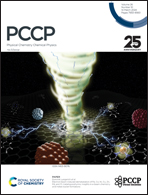Insights into ultrafast decay dynamics of electronically excited pyridine-N-oxide†
Abstract
The ultrafast decay dynamics of pyridine-N-oxide upon excitation in the near-ultraviolet range of 340.2–217.6 nm is investigated using the femtosecond time-resolved photoelectron imaging technique. The time-resolved photoelectron spectra and photoelectron angular distributions at all pump wavelengths are carefully analyzed and the following view is derived: at the longest pump wavelengths (340.2 and 325.6 nm), pyridine-N-oxide is excited to the S1(1ππ*) state with different vibrational levels. The depopulation rate of the S1 state shows a marked dependence on vibrational energy and mode, and the lifetime is in the range of 1.4–160 ps. At 289.8 and 280.5 nm, both the second 1ππ* state and the S1 state are initially prepared. The former has an extremely short lifetime of ∼60 fs, which indicates that the ultrafast deactivation pathway such as a rapid internal conversion to one close-lying state is its dominant decay channel, while the latter is at high levels of vibrational excitation and decays within the range of 380–520 fs. At the shortest pump wavelengths (227.3 and 217.6 nm), another excited state of Rydberg character is mostly excited. We assign this state to the 3s Rydberg state which has a lifetime of 0.55–2.2 ps. This study provides a comprehensive picture of the ultrafast excited-state decay dynamics of the photoexcited pyridine-N-oxide molecule.



 Please wait while we load your content...
Please wait while we load your content...